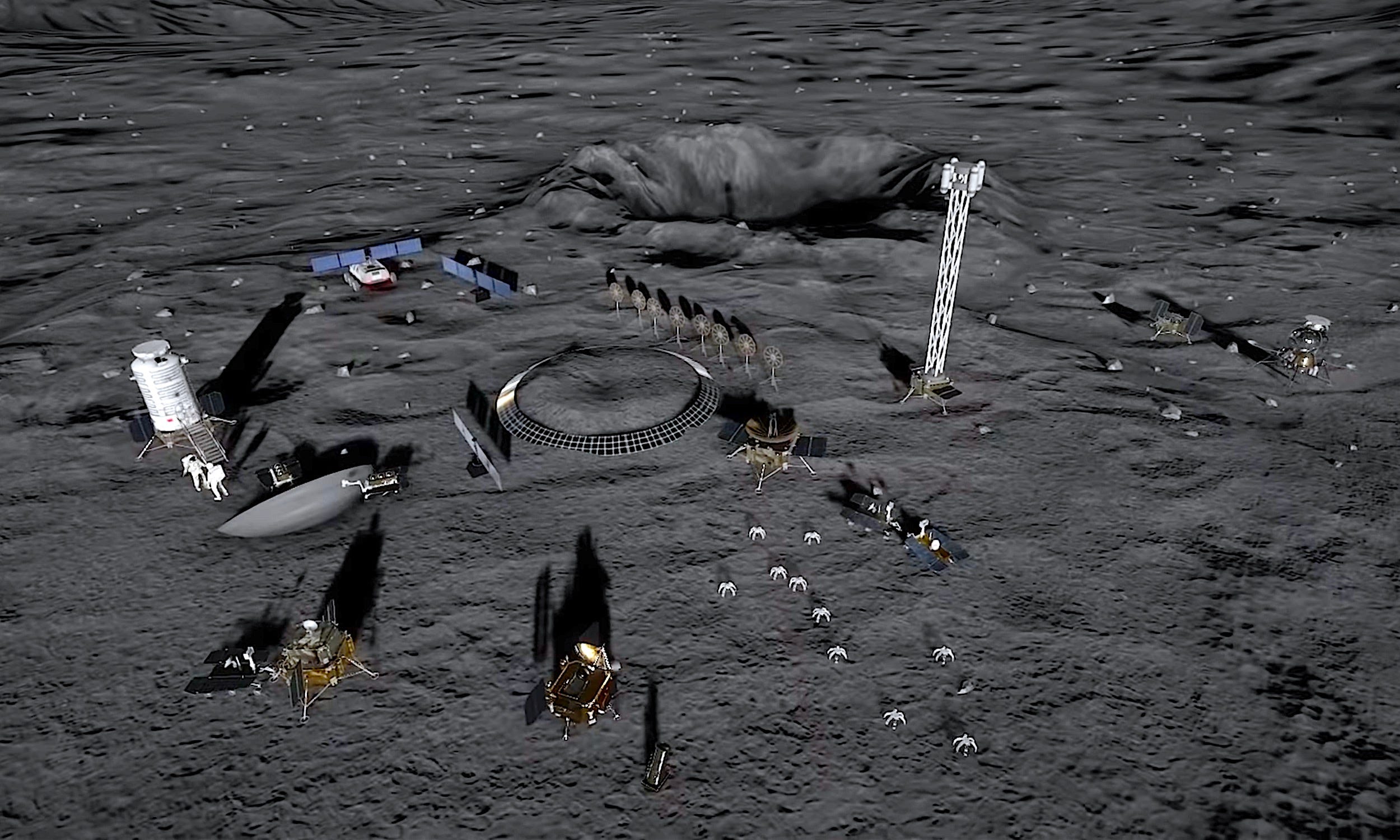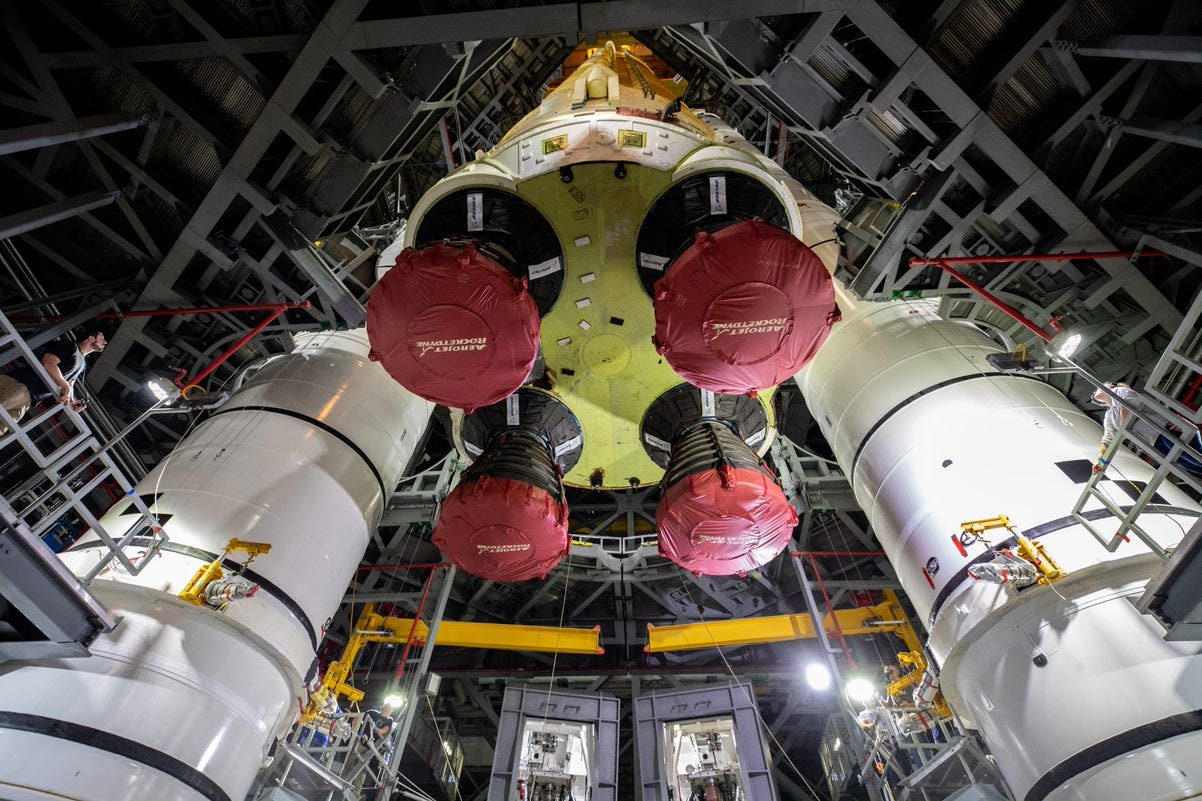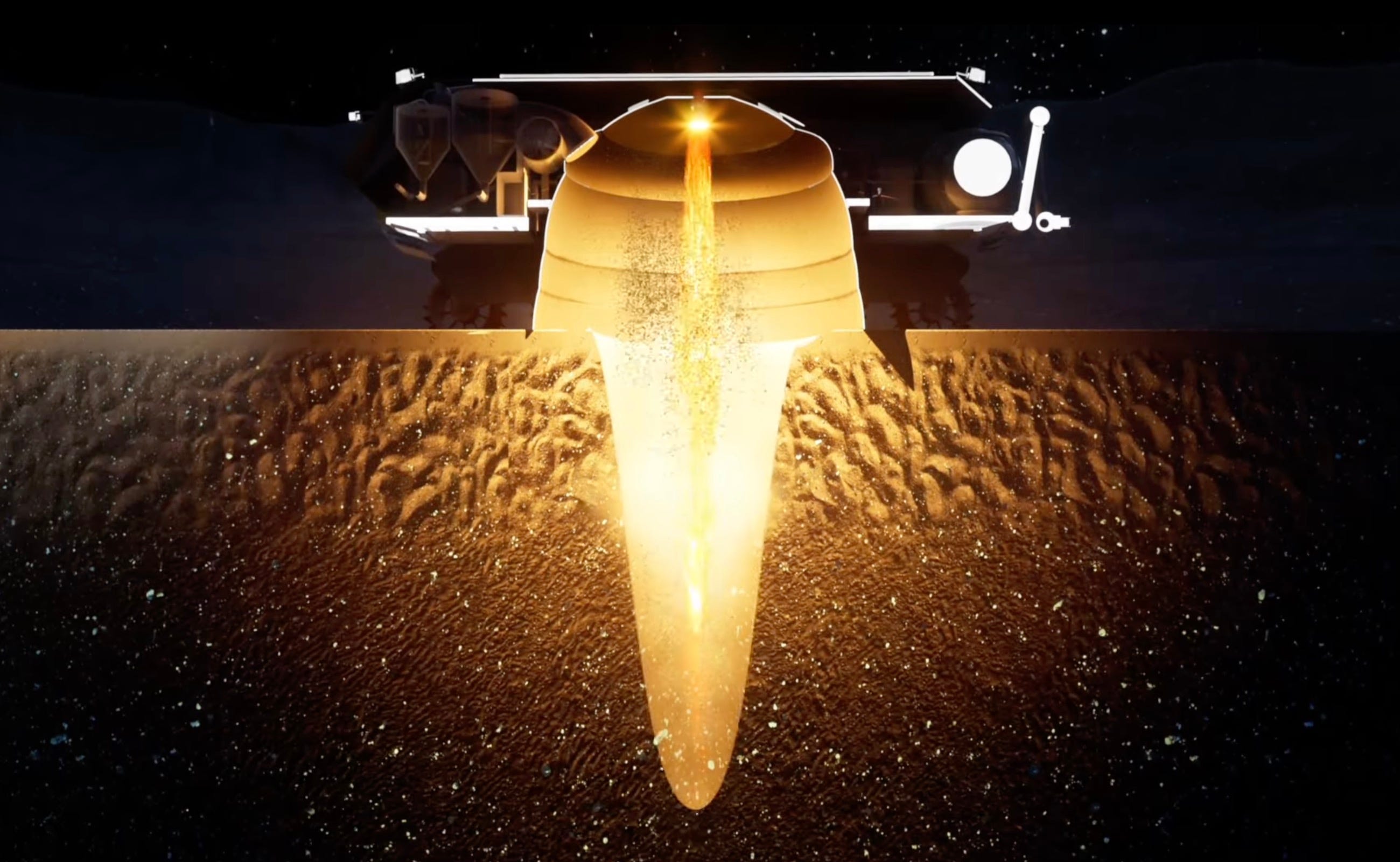Moon Monday Issue #32
China and Russia reveal Moonbase plans, NASA's SLS stacking up for launch, Japan passes space resources bill, Masten teases a Moon water miner, better seeing permanently shadowed regions, and more.
Highlight
Edit on May 29, 2024: This section of the article is now superseded by Moon Monday #177. Visit there to read the latest on China’s Moonbase plans.
At the Global Space Exploration Conference (GLEX) last week, China and Russia formally revealed their initial plans for the International Lunar Research Station (ILRS), their long-term scientific base on the Moon.

The project will have 3 phases:
- Reconnaissance (2021-2025): Missions from both space agencies will help choose a location for ILRS, preferably on the Moon’s south pole as well as verify high-precision lunar landing technologies. These missions include China’s Chang’e 6 and 7, Russia’s Luna 25, 26 and 27, and any from partner countries that decide to join the project. Chang’e 7 will consist of an orbiter and a lander, the latter of which will deploy a rover and a mini-flying probe to survey the environment and map resources in permanently shadowed regions on the Moon’s south pole.
- Construction (2026-2035): Between 2026-2030, Chang’e 8 and Luna 28 will deliver cargo to the selected site to begin setting up the base infrastructure. This stage of ILRS is also when the two countries will conduct and verify joint operations of assets at the base. Missions from any partners can add additional infrastructure during this time. Between 2031-2035, the then-ready Chinese and Russian super heavy-lift vehicles, such as the planned Long March 9, will deliver critical infrastructure for sustainable use via missions named ILRS-1 through 5 for energy needs, communications, transportation services (including ascent vehicles, landers, hopping landers, and rovers), scientific research equipment, in-situ resource utilization technologies, and more. This period would also be when the countries deploy infrastructure in orbit such as relay satellites, and set many things at the base to operate largely autonomously.
- Utilization (2036 onward): At this point, the ILRS is assumed to have been completed, and ready for human missions. The base will be used to conduct long-term science and exploration, support long-term human stays, and will be expanded as needed thereon.
As the next step, China and Russia will produce a legal framework by the end of the year laying out the principles of ILRS and exactly how entities can participate. Wu Yanhua, deputy head of the China’s space agency, said that many countries and organizations have expressed interest in the ILRS, including the European Space Agency, France, UAE, Thailand, and Saudi Arabia. Wu noted that these discussions are at a very early stage, and that private companies aren’t ruled out from participating either. The initial ILRS roadmap document lays out various options for partners to collaborate on the project.
Judging by the initial plans, China and Russia’s ILRS Moonbase seems to be moderately paced, compared to NASA’s swift Artemis ambitions. In related news, on June 15, Brazil signed the U.S.-led Artemis Accords. Brazil is the the 12th country worldwide to sign the Accords, and the first in South America.
Exploration
The SLS rocket’s core stage has been stacked between the rocket’s twin solid boosters in preparation for NASA’s Artemis I mission launch later this year or early next. This completes the rocket’s first stage assembly, and will be followed by stacking the rest of the rocket, with the Orion spacecraft on top. Spaceflight now has more details on the process of mating the core stage and the boosters.

In related news, NASA is adding a dummy to the Artemis I flight, joining the two dummies from ESA onboard the Orion spacecraft which will have over 5,000 radiation sensors to measure radiation exposure to future crew. NASA’s dummy, also equipped with a few radiation sensors, will be suited and occupy the commander’s seat. The seat will have two sensors—one under the headrest and another behind the seat—to record acceleration and vibration throughout the mission. Five additional accelerometers inside Orion will complement that data, including for the spacecraft’s final phase of the mission—bounced atmospheric reentry and splashdown. NASA and ESA will use these comprehensive datasets to best protect astronauts for Artemis II, the first crewed mission to the Moon under the Artemis program.
The Japanese parliament passed a bill on June 10 that allows Japanese companies to extract space resources and use them, with permission from the government. Japan is the fourth country to pass such a law, joining the U.S., Luxembourg, and UAE. Notably, all fours of these countries have signed the US-led Artemis Accords, which endorses extract and using space resources. The Japanese company ispace, inc. is set to benefit from this law, seeing that it already has several contracts or MoUs with multiple space agencies, including the Japanese space agency, that aid towards the eventual extraction and use of space and lunar resources. SpaceNews reports that Russia’s disagrees with this direction of nations adopting their own laws for space resources; they think the United Nations should regulate this instead.
Related: Last week, the Open Lunar Foundation shared a statement at a United Nations COPUOS meeting, urging them to further discuss space policy and governance issues for lunar activities and resources, especially considering that the Moon will be our preview of things to come. As a reference solution, Open Lunar made the case for polycentric governance via a memo provided to the committee.
Masten Space has announced that they’re designing a mobile rocket mining system called Rocket-M, to be onboard a Lunar Outpost provided large rover at some point, to rapidly extract large quantities of water ice and other volatiles from permanently shadowed regions on the Moon’s poles. The rover will fire a 400-Newton-class rocket engine in a pressurized dome to heat the lunar regolith down to at least 2 meters below the surface. Ejected material from the process will enter and be funneled through a Honeybee-Robotics-provided PlanetVac-like system that iteratively separates ice particles from the dust, and stores water as well as dried up metallic lunar soil. Masten claims the rover can mine up to 12 craters a day and produce 100 kilograms of water ice per crater. This is Masten’s plan for collecting lunar water for consumption and fuel, and metals for building habitats. Masten is basing the efficacy of their system on their engine cratering tests on Earth using frozen lunar regolith simulants.

In a discussion with the U.S. Senate regarding additional funding to select another NASA’s Human Landing System provider in addition to SpaceX, the agency’s administrator Bill Nelson revealed that Dynetics had proposed between $8.5-9 billion for their lander whereas Blue Origin’s bid was $5.99 billion and SpaceX’s winning bid was about $2.9 billion.
Science
Researchers at NASA’s Frontier Development Lab have developed an AI algorithm to better see the Moon’s permanently shadowed regions. Since extremely small amounts of starlight and scattered sunlight reflect off of these regions, the AI algorithm removes excessive noise from such images (paper), allowing us to see these dark regions in high resolution for the first time. Being able to identify meter-scale craters and boulders in these dark regions will make it much easier to plan high-level rover and human traverses in future missions, and potentially also allow directly detecting water ice.

Using data from NASA’s Lunar Prospector orbiter, scientists performed a new chemical analysis of the Chang’e 5 landing site. They find that the landing region, which is primarily lava basalts, is contaminated with ejected material from 4 nearby large craters from the rocky highland regions. If traces of these ejecta ended up in the 1.7 kilograms of lunar samples collected by the Chang’e 5 mission, then it would significantly expand the diversity of our Moon samples.
More Moon
Check out Luna Sights, a curated collection of about 50 craters, mountains, lava channels, and more geological features of the Moon. It’s a side project I made through 2018-19 to show people how pretty the Moon is, and learn about the scientific importance of such places while eye-candying them. :)
Thank you SWISSAPOLLO, Epsilon3, and Open Lunar Foundation for supporting me and powering this edition of Moon Monday.
Everyone, I’m publishing this one-of-a-kind Moon exploration newsletter for free, with no ads. And it will stay that way. If you like my work, support me to keep it going. I accept monthly support at various levels as well as one-time donations.
